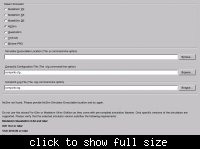mrflibble
Advanced Member level 5
Since this is of use to the fpga programming crowd as well, thought I might as well put it here as well. (original here)
---
Grrrrr, it's 2011 and you still can't pass a simple 2-dimensional input or output to a module in verilog...
Googling didn't really turn up anything , so I put together these quick macros. So far seems to do the trick.
In a real module of course I put the macro's in a seperate .v file and just `include it.
As a matter of naming convention I use "pack_WIDTH_LEN_original_name" so I can keep track of what the hell it is I packed in there.
Anyways, hope it is of some use to a future verilog victim.
---
Grrrrr, it's 2011 and you still can't pass a simple 2-dimensional input or output to a module in verilog...
Googling didn't really turn up anything , so I put together these quick macros. So far seems to do the trick.
Code:
`define PACK_ARRAY(PK_WIDTH,PK_LEN,PK_SRC,PK_DEST) genvar pk_idx; generate for (pk_idx=0; pk_idx<(PK_LEN); pk_idx=pk_idx+1) begin; assign PK_DEST[((PK_WIDTH)*pk_idx+((PK_WIDTH)-1)):((PK_WIDTH)*pk_idx)] = PK_SRC[pk_idx][((PK_WIDTH)-1):0]; end; endgenerate
`define UNPACK_ARRAY(PK_WIDTH,PK_LEN,PK_DEST,PK_SRC) genvar unpk_idx; generate for (unpk_idx=0; unpk_idx<(PK_LEN); unpk_idx=unpk_idx+1) begin; assign PK_DEST[unpk_idx][((PK_WIDTH)-1):0] = PK_SRC[((PK_WIDTH)*unpk_idx+(PK_WIDTH-1)):((PK_WIDTH)*unpk_idx)]; end; endgenerate
module example (
input [63:0] pack_4_16_in,
output [31:0] pack_16_2_out
);
wire [3:0] in [0:15];
`UNPACK_ARRAY(4,16,in,pack_4_16_in)
wire [15:0] out [0:1];
`PACK_ARRAY(16,2,in,pack_16_2_out)
// useful code goes here
endmodule // exampleIn a real module of course I put the macro's in a seperate .v file and just `include it.
As a matter of naming convention I use "pack_WIDTH_LEN_original_name" so I can keep track of what the hell it is I packed in there.
Anyways, hope it is of some use to a future verilog victim.
